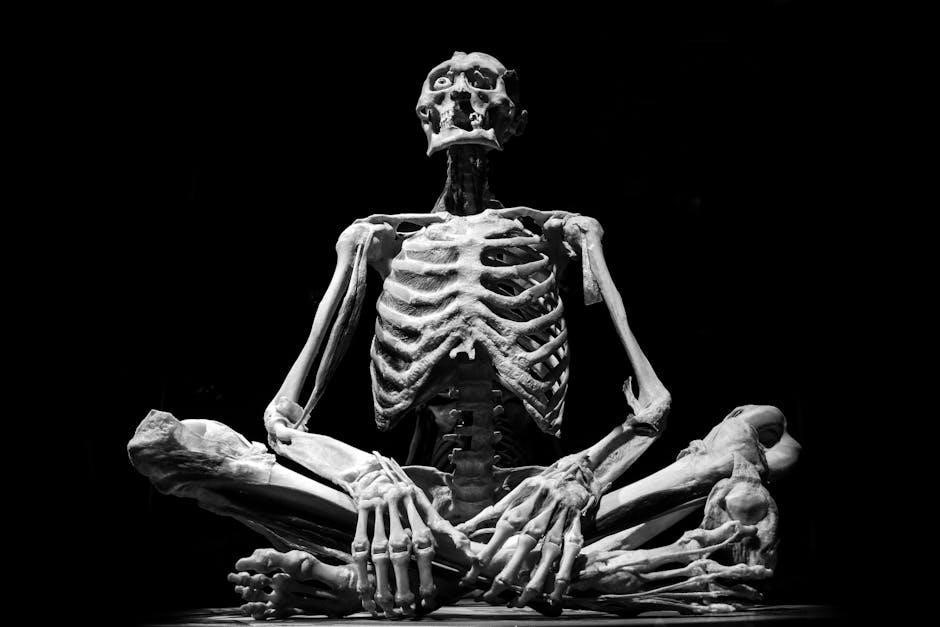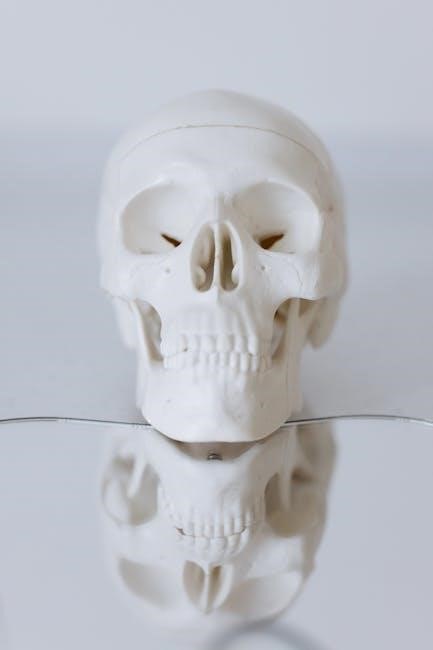The femur bone anatomy is complex, with various parts and functions, as seen in femur bone anatomy pdf documents available online for study and reference purposes only today․
Overview of the Femur Bone
The femur bone is a long bone that plays a crucial role in the human skeletal system, as discussed in femur bone anatomy pdf documents․ It is the longest and strongest bone in the body, extending from the hip joint to the knee joint․ The femur bone has a unique structure, with a rounded head at the upper end and a widened lower end that forms two large condyles․ This bone is essential for supporting the body’s weight and facilitating movement․ According to online resources, the femur bone is composed of various parts, including the shaft, neck, and condyles, which work together to enable a range of motions․ By studying the femur bone anatomy pdf, individuals can gain a deeper understanding of the bone’s structure and function, as well as its importance in the human body․ This knowledge can be useful for various purposes, including medical and educational applications․

Femur Bone Structure
The femur bone has a complex structure with various components and functions described in femur bone anatomy pdf documents available online for study purposes only today always․
Parts of the Femur Bone
The femur bone is composed of several distinct parts, including the head, neck, and shaft, as well as the greater and lesser trochanters, which are described in detail in femur bone anatomy pdf documents․
These parts work together to form a strong and stable joint, allowing for a wide range of motion and supporting the body’s weight․
The head of the femur is a rounded structure that articulates with the acetabulum to form the hip joint, while the neck is a narrow region that connects the head to the shaft․
The shaft is a long, cylindrical structure that makes up the majority of the femur bone, and the greater and lesser trochanters are bony projections that serve as attachment points for muscles and ligaments․
Overall, the femur bone is a complex and fascinating structure, and studying its parts and functions can provide valuable insights into human anatomy and physiology, as discussed in femur bone anatomy pdf resources available online․
Understanding the different parts of the femur bone is essential for medical professionals and students of anatomy, and can be achieved through careful study of femur bone anatomy pdf materials and other educational resources․

Femur Bone Landmarks and Measurements
Femur bone anatomy pdf documents describe various landmarks and measurements, including length and diameter, used to identify and study the femur bone structure and function accurately online․
Identifying Key Landmarks and Taking Measurements
To identify key landmarks and take measurements of the femur bone, one can refer to femur bone anatomy pdf documents, which provide detailed diagrams and descriptions of the bone’s structure and function․
These documents can be used to learn about the different parts of the femur, including the head, neck, and shaft, as well as the various landmarks and measurements that can be used to identify and study the bone․
By using these documents, individuals can gain a better understanding of the femur bone and its role in the human body, and can develop the skills and knowledge needed to accurately identify and measure the bone’s key landmarks․
This information can be useful for a variety of purposes, including medical and scientific research, education, and training․
Overall, femur bone anatomy pdf documents are a valuable resource for anyone looking to learn about the femur bone and its anatomy․

Learning Objectives for Femur Anatomy
Students will understand femur bone anatomy pdf concepts and apply knowledge to identify and describe femur structures and functions accurately and effectively every time online․
Key Skills to Master
To master femur bone anatomy, students need to develop several key skills, including the ability to identify and describe the different parts of the femur, such as the head, neck, and shaft, as well as its surrounding structures and landmarks․ They should also be able to explain the functions of the femur and its role in the skeletal system, and demonstrate an understanding of the relationships between the femur and other bones in the lower limb․ Additionally, students should be able to analyze and interpret femur bone anatomy pdf diagrams and illustrations, and apply their knowledge to real-world scenarios and case studies․ By mastering these skills, students will gain a comprehensive understanding of femur bone anatomy and be well-prepared for further study and practice in the field․ This will enable them to make informed decisions and take appropriate actions․

Interactive Learning Tools for Femur Anatomy
Utilize online quizzes and diagrams to enhance learning of femur bone anatomy pdf and related topics effectively today․
Diagrams and Quizzes for Consolidating Knowledge
Utilize online resources such as diagrams and quizzes to enhance learning of femur bone anatomy, as seen in femur bone anatomy pdf documents․
These tools can be used to test identification skills and consolidate knowledge of the femur bone․
The diagrams can be labeled or unlabeled, allowing users to test their understanding of the different parts of the femur bone․
Quizzes can also be used to assess knowledge and identify areas for further study․
By using these interactive tools, users can gain a deeper understanding of femur bone anatomy and improve their ability to identify and describe the different parts of the bone․
This can be particularly useful for students and professionals in the field of anatomy and related disciplines․
The use of diagrams and quizzes can also make learning more engaging and fun, helping to maintain user interest and motivation․
Overall, diagrams and quizzes are valuable tools for consolidating knowledge of femur bone anatomy;
